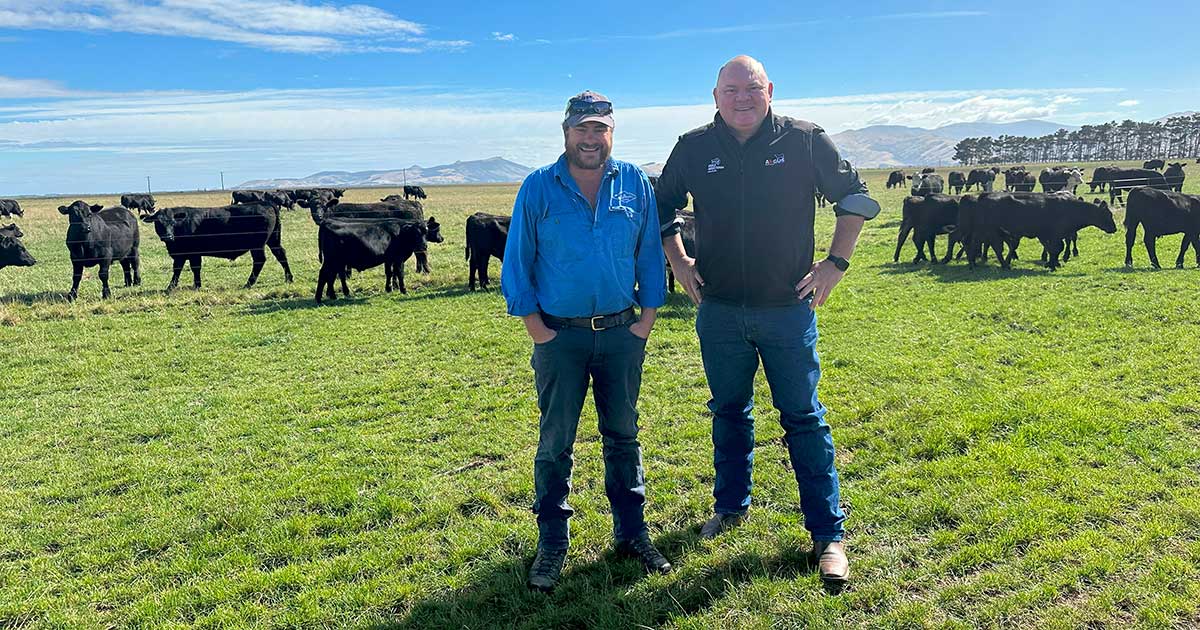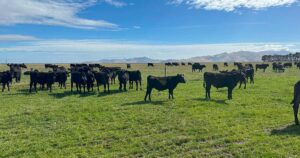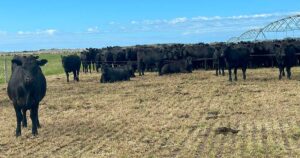Beef on Dairy at Willesden Farms


Matt Iremonger is a passionate advocate for a renewed Beef on Dairy system based on genetic performance. Sitting around the farm office it quickly becomes clear that Matt is a fountain of knowledge on the subject following his Nuffield Scholarship and the opportunity to study the global beef on dairy industry.
Matt and his wife Katy manage Willesden farms in the Banks Peninsula on the east coast of the South Island of New Zealand. They also have some ownership equity in the company. When the business expanded into dairy 3 – 4 years ago Matt and Katy decided for ethical reasons that they wanted to reduce the wastage of the bobby calves. That was their driving determination to create a profitable beef on dairy enterprise.
New Zealand has 4 million head of beef cattle, of which Angus is the dominant breed with over 33% market share. In comparison the New Zealand dairy industry has 6.2 million head of cattle which are producing offspring into the beef industry every year. The beef on dairy animals contribute significantly to New Zealand beef production systems and meat exports each year.
While milk remains the primary profit driver in the dairy industry, Matt saw an opportunity to enhance returns from dairy calves, particularly through crossbreeding with Angus cattle.
 Historically beef on dairy producers have used ‘discount’ or ‘cheap’ semen sources rather than using high quality genetics specifically tailored for a beef on dairy production system. The traditional result was an animal with sub-optimal genetics which impacted the entire supply chain. The cost of raising a bobby calves hasn’t always been financially viable for different sections of the value chain. This adds to the complexity of establishing beef on dairy as a permanent component of the beef supply chain.
Historically beef on dairy producers have used ‘discount’ or ‘cheap’ semen sources rather than using high quality genetics specifically tailored for a beef on dairy production system. The traditional result was an animal with sub-optimal genetics which impacted the entire supply chain. The cost of raising a bobby calves hasn’t always been financially viable for different sections of the value chain. This adds to the complexity of establishing beef on dairy as a permanent component of the beef supply chain.
Opportunity with Angus:
Beef on dairy in New Zealand has been seen as inferior beef animals but in the USA they are increasingly seen as high value beef animals. This has been done by selecting genetics to maximise the performance of the progeny, adding value to the dairy component without needing to incorporate any maternal traits into the semen being used.
Matt identified an opportunity with Angus genetics, inspired by his study tour to the United States regarding improved feed efficiency, growth rates, and carcass quality in Angus-cross cattle.
The USA experience showed a significant reduction in the feed conversion ratio off these offspring in feedlots dropping from 7:1 to 4:1, indicating the potential for enhanced profitability in beef on dairy programs by selecting the right genetic package. This feed conversion efficiency is enabling Angus beef on dairy calves to meet market specifications at 15 – 18 months of age.
Some of the progeny are on feed the whole time as they are born on a housed dairy farm, then on feed through the dairy program before being transferred into feedlots to finish off and meet market specifications.
Selection Criteria and Breeding Strategy:
Willesden farms uses Breeding Value and Production Value Indexes to select the very best Kiwi Cross cows from which replacements are bred . Sexed semen from high performance Kiwi Cross sires is used to produce dairy replacements. A Kiwi Cross is a Holstein and Jersey crossbred animal that gives the producer a moderate sized cow with the best of both breeds. Generally, they have been stabilized at 60% Holstein and 40% Jersey breed content. The hybrid vigour of these animal produces high productivity, better fertility and greater longevity especially off a pasture-based system.
 Cows that don’t meet the criteria for breeding replacements are mated to selected high performance Angus sires with a desirable genetic package.
Cows that don’t meet the criteria for breeding replacements are mated to selected high performance Angus sires with a desirable genetic package.
In the 2023 mating four sires were used, sires have been selected from the United States beef on dairy programs and one is a New Zealand sire following the same selection criteria.
Traits that Matt looks for in beef on dairy Angus sires are feed efficiency, growth and carcass attributes with a moderate birth weight to go across mature Kiwi Cross cows. The genetic package used is to maximise profitability of the Kiwi Cross Angus offspring and is very different to traits selected for their self-replacing Angus herd.
In 2024 calving they are expecting 500 Angus cross Kiwi Cross calves and looking to increase that to 800 – 900 calves annually within two years.
Benchmarking:
The 2024 Angus cross Kiwi Cross progeny will be DNA tested in order to identify the sire and measure the performance of each sire’s genetics. Through DNA testing Matt wants to identify how much benefit is gained from these feed efficient cattle with carcase attributes in the beef on dairy program.
To effectively benchmark the selected Beef on Dairy sires selected, Matt will compare these with the performance of Angus/ dairy progeny coming out of the New Zealand dairy industry currently. For the 2023 beef finishing system, Willlesden Farms sourced and purchased Angus Kiwi Cross progeny at 120kg to finish as prime animals. These animals were selected based on the genetic sire lines used in the dairy herds and will be the baseline performance the new beef on dairy genetics are compared against.
Feeding Regime:
 Purchasing in Angus Kiwi Cross calves to finish is enabling the Willesden team to learn how to manage and feed these animals to optimise performance. These animals are not given any special treatment and run under their irrigated pasture finishing system.
Purchasing in Angus Kiwi Cross calves to finish is enabling the Willesden team to learn how to manage and feed these animals to optimise performance. These animals are not given any special treatment and run under their irrigated pasture finishing system.
The Angus Kiwi Cross beef on dairy calves were purchased in September and have a daily gain averaging at 1.3kg with the top animals achieving 1.65kg/day. The pasture is post flowering ryegrass and clover pasture watered by centre pivot and stocked at 15 stock units per hectare.
Willlesden Farms own Angus Kiwi Cross Genetics will be calve down in July – September. These animals will be reared on farm and grown out on an irrigated grass system. 60% of their Dry Matter at Willseden Farms is grown in a six-week period from middle of October to December.
An option to help manage the pasture growth curve is to implement a feedlot system. Matt is considering options such as a Compost Barn to help these animals in their last 60 – 70 days prior to processing by feeding them a grain ration. Ideally, they would like to get these animals off farm as soon as possible and before their second winter.
Future Outlook:
Matt’s studies into the Beef on Dairy industry has shown there are ways to improve the profitability in what is currently seen an a ‘by-product’ of the dairy industry. To understand the industry in detail, ongoing evaluation and adaptation are essential to ensure continued success.
Matt remains open to market feedback and technological advancements, emphasizing the need for sustainable practices and strategic collaborations within the industry. Willseden farms are still establishing their ideal market for the Angus Kiwi Cross progeny. They are also open to working with other finishers to create a volume of supply to meet market specifications.
The future:
Matt’s case highlights the potential for dairy farmers to optimize revenue streams through strategic crossbreeding initiatives. Leveraging Angus genetics and implementing sound breeding and management practices, dairy farmers can enhance the value of their operations while contributing to the overall sustainability of the industry.
Producing a product with a genetic package of feed efficiency, growth and carcase attributes will add value to each member in the beef on dairy supply chain.
Feature Image: Matt Iremonger, Willesden Farms and Angus Australia CEO Scott Wright
Nancy Crawshaw, Extension Officer